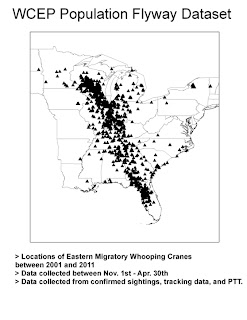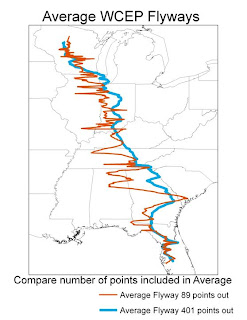Wednesday, when I found 1/2 the population of whooping cranes within an 8 mile radius, I identified an injured whooping crane. She had twine wrapped around her right leg so tight, it caused a swelling so large it looked like a second hock. She wasn't placing any weight on her leg, so I called Eva right away.
 |
| 17-07 using wings to step forward |
17-07 is 4 years old. Two weeks ago, Eva saw her with a slight limp, but didn't observe any twine. It wasn't notable at the time since wild birds will develop a limp and miraculously heal within a week sometimes. This time, when I saw her, I was very alarmed at her limp and the swelling around the twine. While other cranes danced around her, foraged in the corn, and acted generally crane-y, she just rested on her left foot and poked around her at the corn nearby. I watched her for an hour trying to get video footage of her behavior. She didn't move around very much and when she did, she used her wings to assist her movement.
After working long hours on Wednesday, finding landowners and obtaining permission to go on their land, we were ready to go for Thursday. Thursday morning, Eva and I found the cranes weren't on that land anymore. Oh well. So we worked another couple hours trying to find the new landowners and get their permissions. It's a little disappointing when that happens: we were pawing at the gates to begin our capture adventure on Thursday only to be set back by the cranes' desire to forage on new land.
OK, so we got permission, and by late Thursday afternoon, we had our team organized: Richard Urbanek (a.k.a. Crane Guru), Eva, and myself. This was an opportunistic capture because her transmitter is dead; we planned to remove the twine binding her leg AND put new leg bands on. Awesome! I think the saying goes 'two birds with one stone.'
Sadly, on that late Thursday evening, the birds flew off both times we approached the birds in cornfields. Maybe they flew because we were trying to entice the birds with corn in a corn field. Maybe they flew because the birds felt less secure in a cornfield than they do in a marsh. Who's to say?
We regrouped for a Saturday morning capture. This time, we were without Richard Urbanek, so we couldn't replace the transmitter. We also couldn't capture the birds with our usual capture technique with the Net Gun. We were handicapped by our need to be close enough to physically grab the bird before she flew away. Nonetheless, we moved forward with the plan because it is only humane and right that we remove the fishline from 17-07's leg. Otherwise, it would eventually lose circulation and fall off.
Saturday morning, the team included Nancy and Annette, 2 vet techs who are experienced in field medicine and animal rehabilitation, Eva and myself. THIS time the cranes were on land we had permission to enter so we got started right away.
Eva and myself walked up to a group of 7 whooping cranes (27-10, Feta, included :), and they didn't fly off! Odds of capture were looking good. As Eva and I pretended to be cranes, chucked grapes at the greedy adults, and worked our way closer, 17-07 didn't react. Eva moved slowly towards 17-07 while I distracted the other 6 cranes, including 17-07's suspicious 'boyfriend,' 10-09. Finally Eva was close enough! There was a brief struggle of feathers and costume but Eva quickly had 17-07 in hand and walked her back to our mini field station. We had set up in the tall grasses to block the view of the other birds.
 |
| Eva moves slowly towards injured 17-07 |
Nancy and Annette analyzed the wound, removed the fishing line, and took pictures while Eva held the bird. I warded off unwanted company (meaning the 6 other whooping cranes who rushed to investigate).
 |
| Removing the twine carefully with suture scissors |
 |
| Right leg swelling due to pressure from the twine |
 |
| After the twine was removed the swelling should go down |
When I was satisfied the other birds would stay at the other end of the pond, I returned to assist in any way I could. Eva had me remove the old, non functioning transmitters. 17-07 is now the only bird in the Eastern Population that does not have any color bands to identify her.
 |
| I'm removing the non-functioning transmitters |
The vet techs have decreed that she is in good standing. She should recover very quickly (they suggested she'd recover within the week!) because we removed the fishing line before it caused severe damage. If we had not caught her the tissue around the twine would continue to swell, working the twine farther into the leg and cutting off circulation.
 |
| Eva releases the bird into the marsh |
I feel so great about this capture today! We were lucky with the crane's location, landowner permission, disposition of the cranes, and everything else that went right today. I only wish we could have re-banded her while we had her in hand.
 |
| Can you believe this fit around her leg? |




















































